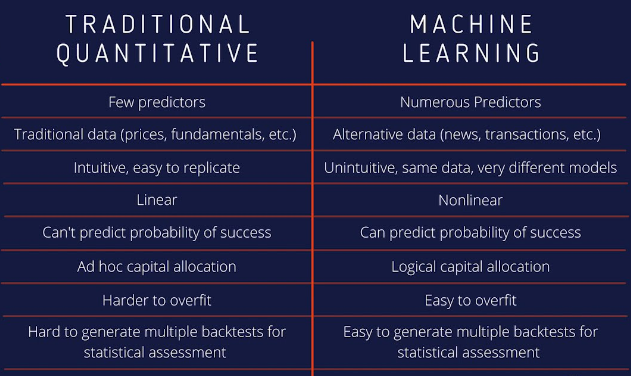Quantitative learning, machine learning, and deep learning are related fields but have distinct differences. Here are some key differences between them:
- Scope and Focus:
- Quantitative learning: Primarily focuses on applying mathematical and statistical models to analyze financial data, make predictions, and optimize investment strategies in the domain of finance.
- Machine learning: Broadly refers to the development of algorithms and models that enable computers to learn from and make predictions or decisions based on data. It has applications across various domains, not limited to finance.
- Deep learning: A subfield of machine learning that focuses on building and training deep neural networks with multiple layers to learn representations and patterns directly from data. It excels in processing complex, high-dimensional data such as images, audio, and text.
2. Data Requirements:
- Quantitative learning: Relies on historical and real-time financial data, including prices, volumes, interest rates, economic indicators, etc., to build mathematical models and derive insights for decision-making.
- Machine learning: Requires labeled or unlabeled training data that represents examples or patterns relevant to the learning task. The data can be diverse, including numerical, categorical, textual, or image data.
- Deep learning: Relies on large-scale labeled datasets to train deep neural networks effectively. It often requires substantial amounts of data to learn complex patterns and generalize well.
3. Techniques and Models:
- Quantitative learning: Utilizes various quantitative techniques such as statistical models, time series analysis, optimization methods, econometrics, and financial mathematics to analyze and model financial data.
- Machine learning: Encompasses a wide range of algorithms and models, including decision trees, random forests, support vector machines (SVM), logistic regression, naive Bayes, k-nearest neighbors (KNN), and more. It focuses on learning patterns and relationships in data to make predictions or decisions.
- Deep learning: Primarily relies on deep neural network architectures, such as convolutional neural networks (CNN) for image processing, recurrent neural networks (RNN) for sequential data, and transformer models for natural language processing. Deep learning models can automatically learn hierarchical representations from data.
4. Interpretability:
- Quantitative learning: Often emphasizes interpretability, as the models are built based on mathematical and statistical principles. The relationships and insights derived from these models are typically explainable and understandable.
- Machine learning: Provides a mix of interpretable and less interpretable models. While some algorithms like decision trees or linear regression offer interpretability, complex models like neural networks can be harder to interpret due to their high dimensionality and non-linearity.
- Deep learning: Deep neural networks are generally considered less interpretable compared to traditional statistical models or simpler machine learning algorithms. The high complexity of deep architectures and the large number of parameters make it challenging to interpret the learned representations and decision-making process.
5. Application Domain:
- Quantitative learning: Primarily focused on financial markets, investment management, risk assessment, and related areas within the finance industry.
- Machine learning: Applied across various domains, including image and speech recognition, natural language processing, recommendation systems, fraud detection, autonomous vehicles, healthcare, and more.
- Deep learning: Widely used in computer vision, speech recognition, natural language processing, and other domains where complex patterns and hierarchical representations are essential.
While there are overlaps and interactions between these fields, understanding the distinctions helps clarify their respective areas of focus and methodologies. It’s worth noting that machine learning and deep learning techniques can also be applied within the domain of quantitative learning to enhance analysis and decision-making in finance.

Thank you for this informative article. It helped me comprehend the subject better. Nice!